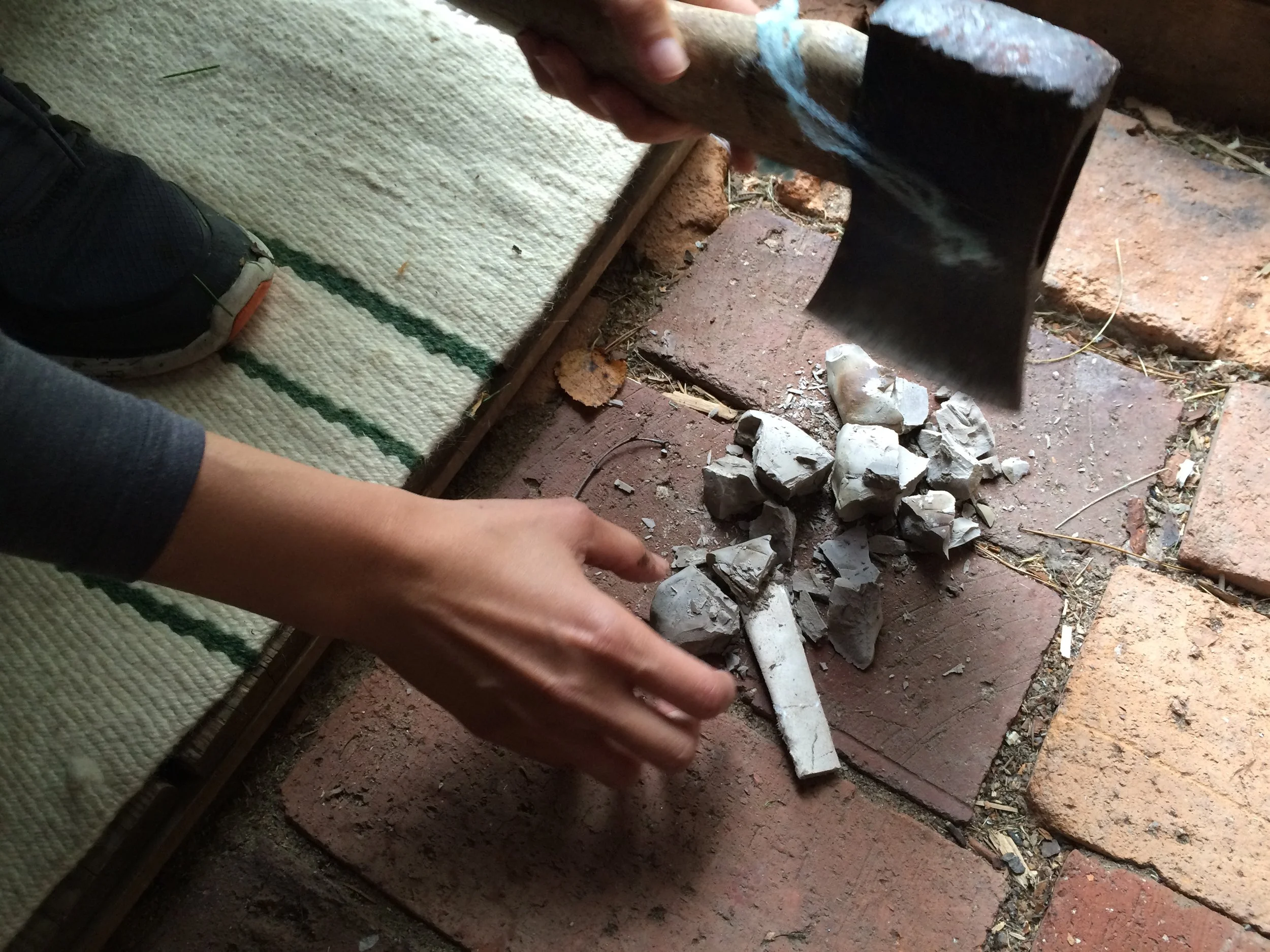








collaborative performance, two-channel video, and sound installation with assyriologist Saana Svärd
"Floating Platforms: Encounters between performance art and science"; Titanik Gallery; Turku, Finland. 2015
As part of Floating Platforms, assyriologist Saana Svärd and I worked together to explore our analogous interests in fragmented meanings. Whereas assyriologists make meaning from found fragments of text, my work often presents texts or narratives in a way that only fragments can be perceived and new subjective meanings are created.
From our conversations and documents exchanged, I was astounded to learn that we are able access the internal lives of humans who lived five millennia ago via a plethora of clay writing tablets. These tablets survived not only the ravages of time, but recurrent pillage and plunder.
Important administrative or official tablets were kiln-fired for permanence, but many personal correspondences were inadvertently preserved by invading armies that burned entire cities to the ground. Whereas immeasurable quantities of human knowledge has been lost forever in the destruction of great libraries of Alexandria and others, we still have today a five thousand-year-old letter from a mother-in-law to her son-in-law essentially telling him off for being a dick.
On our first day together in Turku, Svärd mentioned that the Great Fire of Turku is very much a loss that is still felt by people here. Because Turku was at that time the most important city in Finland, nearly all of Finnish archives were lost in the blaze. As a result, the Imperial Academy of Turku was transferred to Helsinki and Turku’s significance waned considerably.
With the idea of somehow giving resilience to, or symbolically resurrecting these losses, we began collecting anonymous stories of significant personal loss from Turku citizens. At the same time we experimented with clay, making cuneiform tablets of our own and marvelling at what satisfying objects they turned out to be. These hand-sized sculptures had a hefty weight and girth to them, and when carefully smoothed and fired, they resembled river pebbles.
We transcribed the stories of people’s losses onto parchment, embedded the scrolls in clay envelopes, then baked them in fire. In this way, these precious memories now gained a sort of resilience.
On vernissage night, we invited the audience to think about what they cherish most, write it on a piece of parchment, then offer this scroll in exchange for a ceramic envelope containing someone’s significant loss. Two videos depicting the making process looped in a second gallery, and a sound installation featuring layered stories of loss occupied a third gallery.
The line between fiction and reality is tenuous and mutable. In this performance/installation, we use the real-life narratives of Turku citizens as our content. These accounts of personal loss are “real” in that they actually occurred. But they are also “fiction” or “constructed” in the way that human memory functions. The work suggests a metaphoric “strengthening” or “resurrection” of these losses. At the same time, it also has the potential to perhaps catalyze psychological closure.
***
The key purpose of the Floating Platforms project was to create a platform for new kind of encounters between performance art, science and humanities. The project, organized by Aboagora Symposium and New Performance Turku Festival, provided means and perspectives for an equal dialogue between performance artists, scientists and researchers. The starting point was to encourage the pairs to work from their own perspectives as well as encourage into new and unexpected encounters.
Floating Platforms resulted in six separate performances, of which three were presented during the Aboagora symposium and other three at the New Performance Turku Festival. The project organized a closing seminar on November 3rd 2015 and will publish an e-publication in 2016.
Saana Svärd (b. 1977) is a researcher at the University of Helsinki. Based on Mesopotamian written sources – mostly cuneiform writing on clay tablets – her interests include women’s power in the Neo-Assyrian Empire and the construction of gender in Mesopotamia from 934-330 BCE.
Other artist/scientist/researcher pairs included: Joshua Sofaer and cognitive neuroscientist Mikko Sams, Marcio Carvalho and international politics researcher Eeva Puumala, Leena Kela and cosmologist Kaisa Henttunen, Kurt Johannessen and biologist Mia Rönka, Juha Valkeapää and sound archaeologist Riitta Rainiö
CURATORS
Leena Kela, artistic director, New Performance Turku Festival
Christopher Hewitt, artistic director, New Performance Turku Festival Hannu Salmi, professor, University of Turku / Cultural History
Ruth Illman, director, Donner Institute (Åbo Akademi Foundation)
Asko Nivala, researcher, University of Turku / Cultural History
Anna Haapalainen, researcher, University of Turku / Comparative Religion
PRODUCTION & COMMUNICATIONS
Anni Välimaaki, coordinator, producer, University of Turku / Cultural History
Virpi Vairinen, publicist, New Performance Turku FestivalThe
Floating Platforms project is organized by two Turku-based organizations interested in counterpoints between arts and sciences.
The Aboagora Symposium is organized by the Department of Cultural History in University of Turku, the Donner Institute of Abo Akademi University Foundation and Turku Music Festival. The Symposium is a three-day event including workshops, lectures and performances with varying topics and covering both scientific and artistic aspects to each year’s theme.
New Performance Turku Festival is an annual international performance and live art festival. The festival takes place on local theaters, museums, contemporary art spaces and the city space introducing the most prominent Finnish and international performance artists to the audience. The festival also organizes discussions and lectures on performance art and has a strong emphasis on collaboration both locally and internationally.
The Floating Platforms project was funded by the Finnish Cultural Foundation.
photos by: Lynn Lu and Otto Vaatainen